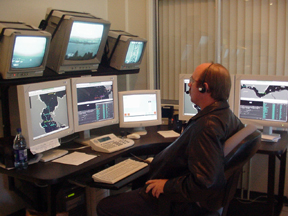Did you ever wonder what keeps all of those high-speed ferries, slow-moving barges, and cargo ships on the Bay from bumping into each other? The answer is the U.S. Coast Guard’s Vessel Traffic Service (VTS) located high atop Yerba Buena Island on San Francisco Bay. The first of its kind in the United States, San Francisco’s VTS celebrated its 30th birthday last month. Unfortunately, we missed the birthday party, but were able to catch up with its head officer, CDR Dave Kranking, who explained, “The establishment of the VTS on San Francisco Bay in August 1972 was directly related to the 1971 collision of two oil tankers underneath the Golden Gate Bridge. In the aftermath of that collision, two acts were passed by the U.S. Congress: the Bridge-to-Bridge Radio Telephone Act, which required ships to communicate with each other on a common radio frequency, and the Ports and Waterways Safety Act, which directed the Coast Guard to establish Vessel Traffic Services, with the first being on San

Coast Guard’s Vessel Traffic Service Celebrates 30th Birthday
By Wes Starratt
Did you ever wonder what keeps all of those high-speed ferries, slow-moving barges, and cargo ships on the Bay from bumping into each other? The answer is the U.S. Coast Guard’s Vessel Traffic Service (VTS) located high atop Yerba Buena Island on San Francisco Bay. The first of its kind in the United States, San Francisco’s VTS celebrated its 30th birthday last month. Unfortunately, we missed the birthday party, but were able to catch up with its head officer, CDR Dave Kranking, who explained, “The establishment of the VTS on San Francisco Bay in August 1972 was directly related to the 1971 collision of two oil tankers underneath the Golden Gate Bridge. In the aftermath of that collision, two acts were passed by the U.S. Congress: the Bridge-to-Bridge Radio Telephone Act, which required ships to communicate with each other on a common radio frequency, and the Ports and Waterways Safety Act, which directed the Coast Guard to establish Vessel Traffic Services, with the first being on San Francisco Bay.
We asked, how does it work?
CDR Kranking: “Through a network of radar, radio communications, and closed-circuit television, we monitor most vessels that are underway on the Bay. There are federal regulations in place that require certain types of vessels to participate in the VTS service, which means that they have to call the Coast Guard at specified times with information on their point of departure, destination, and route. With that information and the ability to track those vessels by radar, we maintain displays in our Year Buena Island Traffic Center showing where all of those vessels are on the Bay. Then, we ensure that each vessel is aware of who else they may encounter along their transit route, and monitor the vessels to be certain that they are passing at safe distances and that they are communicating with each other when necessary.”
Can you compare the VTS with Air Traffic Control?
CDR Kranking: “The operative work in Air Traffic Control is “control,” with commands given to the aircraft. We do not exercise that control, except as a last resort. We monitor the ships and where they are. We inform them of who else is in the area that they may encounter along the way. We may make recommendations to them and, if necessary, issue directions. But, we rarely, if ever, give orders to the master of a ship, since the person in actual control of a vessel is in the best position to understand critical elements, such as winds, currents, water depths, and other factors affecting his ship. In short, we’re keeping track of who is where and trying to help them avoid hitting each other.”

